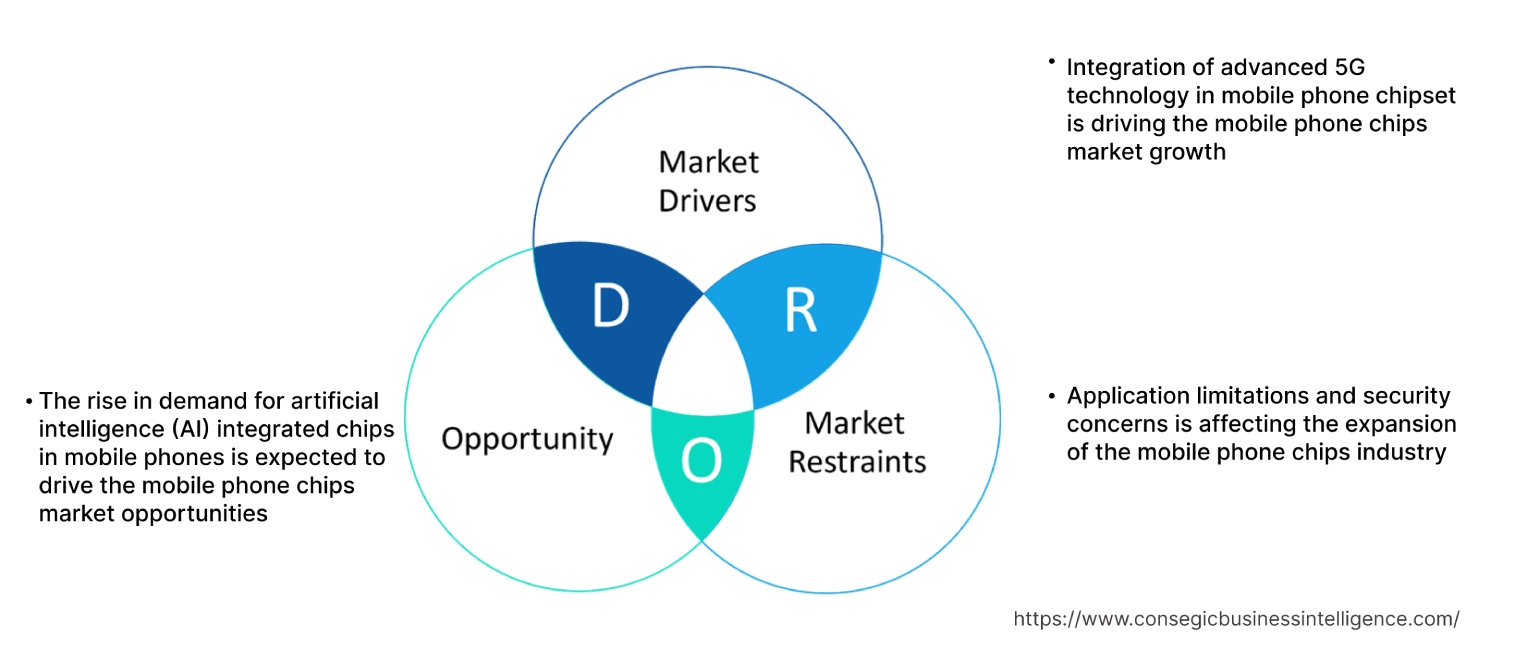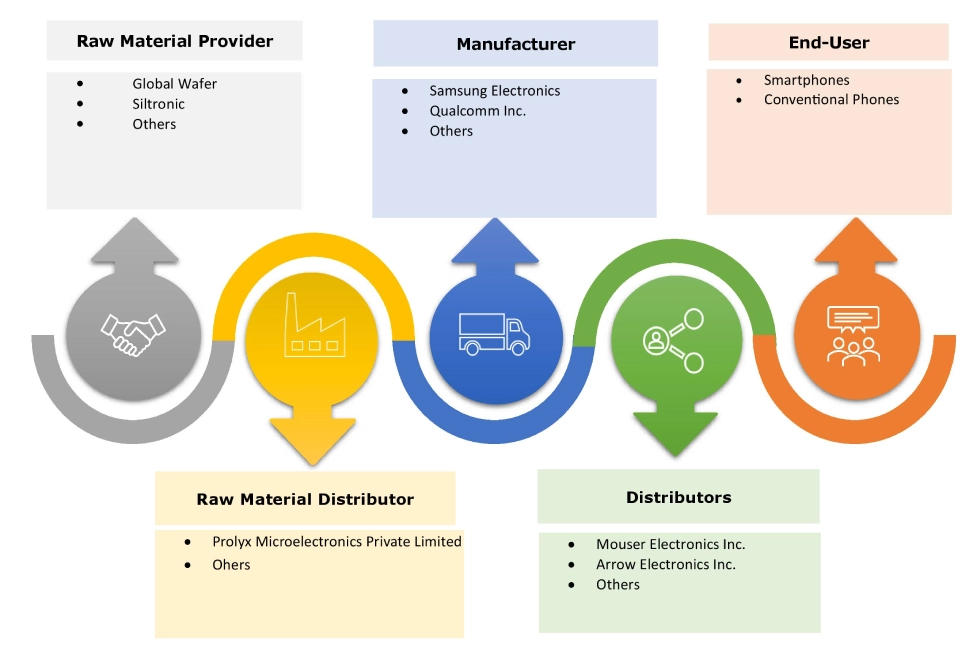Mobile Phone Chips Market Size:
Mobile Phone Chips Market size is estimated to reach over USD 166.77 Billion by 2032 from a value of USD 111.87 Billion in 2024 and is projected to grow by USD 115.52 Billion in 2025, growing at a CAGR of 5.5% from 2025 to 2032.
Mobile Phone Chips Market Scope & Overview:
Mobile phone chips, also known as system-on-a-chip (SoC), are integrated circuits that virtually manages all the functions of a smartphone. Moreover, SOCs incorporate various components into a single chip which further enable faster processing speeds, allowing improved application performance and smoother task management. Additionally, a mobile phone chip provides various benefits such as faster performance, improved battery life, support for advanced features, power management, memory and storage interface and others. Furthermore, smartphone chips equipped with artificial intelligence processors and neural processing units are optimized for machine learning and AI tasks.
Mobile Phone Chips Market Dynamics - (DRO) :
Key Drivers:
Integration of advanced 5G technology in mobile phone chipset is driving the mobile phone chips market growth
The integration of 5G technology in mobile phone chipset enables 5G capabilities and power efficient technologies in smartphones. Moreover, 5G chipsets facilitates significantly faster data speeds, which is ideal for applications requiring virtual reality, augmented reality, real time data transmission and others. Additionally, 5G chipsets support dynamic network slicing, which allows operators to customize network services to specific application requirements. Furthermore, 5G chipsets support multiple-input, multiple-output (MIMO) technology, allowing simultaneous communication with multiple devices.
- For instance, in July 2024, Unisoc launched Unicsoc T760 chipset, integrated with 5G technology in India. Moreover, the 5G smartphone chipset comprises of octa core processor and 6nm node type, which improves the overall battery life and operational excellence.
Thus, the integration of advanced 5G technology in smartphone chips is driving the mobile phone chips market growth.
Key Restraints:
Application limitations and security concerns is affecting the expansion of the mobile phone chips industry
Mobile phone is comprised of several crucial components such as CPUs, GPUs, modems and other processors that manages all functions of a smartphone. However, mobile phone chip faces some challenges in functionality such as heat dissipation, chip complexity, performance, security concerns and others, which further impacts the mobile phone lifespan. Moreover, high performance smartphones utilize more power to operate, which leads to increase in power consumption and heat generation affecting the battery life.
Additionally, chip design can be complex when dealing with advanced AI features and architecture, which can lead to data complexity and result in reduced model accuracy, increased training time, and difficulty in applicability. Furthermore, security concerns such as malware, spyware, phishing attacks and network vulnerabilities further limit the market growth. Thus, applications limitations and security concerns are further hindering the mobile phone chips market.
Future Opportunities :
The rise in demand for artificial intelligence (AI) integrated chips in mobile phones is expected to drive the mobile phone chips market opportunities
Artificial intelligence chip, also known as AI chip, is specialized chip that is designed to handle vast amount of data quickly and efficiently by enabling real time analysis. Moreover, AI integrated chips integrate a variety of processing units such as GPUs, CPUs, field programmable gate arrays (FPGAs) and application specific integrated circuits. Additionally, AI chips enable communication across different language effortlessly by real time language translation with enhanced voice assistance feature.
- For instance, in 2024, Qualcomm launched its AI chip, hexagon NPU (HTP Gen 4). Additionally, the hexagon NPU is capable of running large language models which facilitates various AI capabilities required by AI algorithms.
Thus, the growing adoption of AI integrated chips in mobile phones is expected to drive the mobile phone chips market opportunities during the forecast period.
Mobile Phone Chips Market Segmental Analysis :
By Core Type:
Based on core type, the market is segmented into dual core, quad core, hexa core, octa core, and others.
Trends in the core type:
- Rising trend in adoption of octa core due to its increased multi-tasking capabilities and enhanced performance is driving the market growth.
- Increasing utilization of hexa core due to its improved multicore efficiency and enhanced performance in multithread applications is driving the mobile phone chip market demand.
Octa core segment accounted for the largest revenue share of 54.21% in the overall market in 2024.
- Octa core is a central processing unit with eight processing cores, which indicates it can handle eight tasks concurrently, making it task efficient.
- Moreover, many smartphones utilize octa core processors to facilitate enhanced performance, smoother multitasking, faster app loading, and enhanced gaming experience.
- In addition, modern octa core often engage with a big.LITTLE architecture, where the cores are divided into two clusters, including big cores for high performance tasks and little cores for less demanding tasks.
- For instance, in September 2024, Qualcomm Snapdragon launched X plus octa core chipset, which offers the latest co-pilot feature. Moreover, these chipsets are developed on 4nm processor nodes and are equipped with the Qualcomm Hexagon NPU chipset.
- Thus, as per the analysis, increasing advancements associated with octa core segment is accelerating the mobile phone chips market size.
Hexa core segment is anticipated to register significant CAGR growth during the forecast period.
- Hexa core is a central processing unit that has six independent processing units working together, which enables to handle six tasks concurrently, making it task proficient.
- Moreover, hexa cores are mainly integrated in high-end mobile devices for efficient functioning of various tasks such as significant computational power, gaming, and running multiple applications.
- For instance, in February 2025, Apple launched iPhone 16e series integrated with its latest generation and hexa core A18 chip. Moreover, hexa core A18 chip offers various benefits including smoother operation functionality, power efficiency, and enhanced battery life.
- Thus, the rising utilization of hexa core chipset in smartphones is expected to propel the mobile phone chips market size during the forecast period.
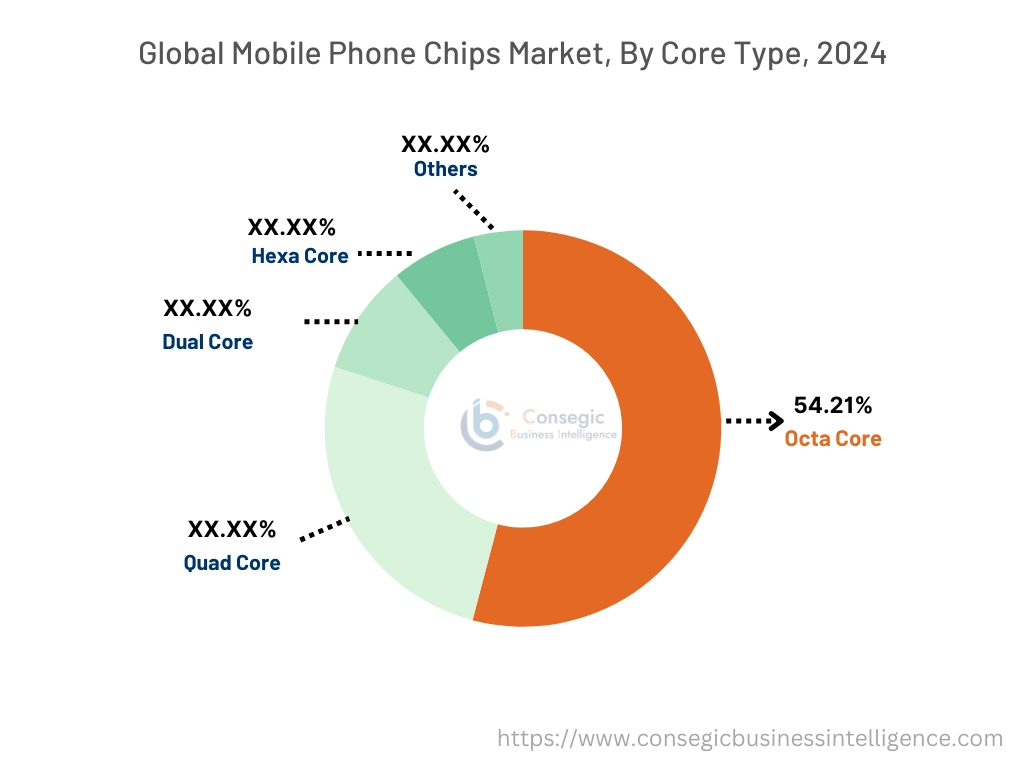
By Processing Node:
Based on processing node, the market is segmented into 2nm, 3nm, 5nm, 7nm, 10nm, 12nm and others.
Trends in the processing node:
- Increasing technological advancements associated with 5nm processing nodes such as integration of artificial intelligence (AI) and machine learning (ML) among others.
- Rising trend in adoption of 3nm processing nodes, due to increasing technological advancements such as improved performance, power efficiency, faster processing speed, and longer battery life.
5nm segment accounted for the largest revenue share in the overall market in 2024.
- 5nm processing nodes are new-generation chips that signify smaller transistor dimension which indicates more transistors packed in one single chip.
- Moreover, smaller transistors can switch faster, which leads to enhanced performance in smartphones.
- For instance, in February 2023, Samsung launch Exynos 1330 chipset, with a 5nm processing node. Moreover, Exynos 1330 provides a longer battery life, and low power design with advanced scheduler and power control technology.
- Therefore, rising advancements related to 5nm processing node segment are driving the mobile phone chips market trends.
3nm segment is anticipated to register substantial CAGR growth during the forecast period.
- 3nm processing nodes are new generation of nodes where the smallest feature size in the manufacturing process is 3 nanometres.
- Moreover, 3nm processing nodes offers various key benefits such as increased transistor density, improved performance, reduced power consumption and others.
- In addition, integration of AI capabilities in 3nm nodes facilitates various benefits such as advanced design, manufacturing optimization, enhanced chip performance, greater efficiency, and others.
- For instance, in September 2023, MediaTek launched its first smartphone chip, which utilizes the 3nm processing node technology from Taiwan Semiconductor Manufacturing Company (TSMC).
- Thus, the rising innovations related to smartphone chips integrated with 3nm processing nodes is projected to drive the mobile phone chips market share during the forecast period.
By End-User:
Based on the end user, the market is segmented into smartphones and conventional phones.
Trends in the end user:
- Increasing adoption of mobile phones chips in smartphones for facilitating improved performance and functionalities is driving the mobile phone chips market trends.
- Increasing trend in utilization of smartphone chips for higher performance, enhanced connectivity and advanced features is propelling the market growth.
Smartphones segment accounted for the largest revenue share in the overall market in 2024, and it is anticipated to register fastest CAGR during the forecast period.
- There is an increasing adoption for smartphones with enhanced features, which is driving the development in chipsets integrated with natural processing units and graphics processing units.
- Moreover, factors such as 5G and AI integration in smartphone chipsets increased processing power, improved power efficiency and others are driving the mobile phone chips market expansion.
- For instance, Apple reported a net sale of USD 391,035 billion in fiscal year 2024 and USD 383,285 billion in 2023. Moreover, there is significant adoption in the sales of the company’s smartphone from the year 2023 to 2024.
- Therefore, the increasing development of smartphone chips for utilization in smartphones is propelling the mobile phone chips market share.
Regional Analysis:
The regions covered are North America, Europe, Asia Pacific, the Middle East and Africa, and Latin America.
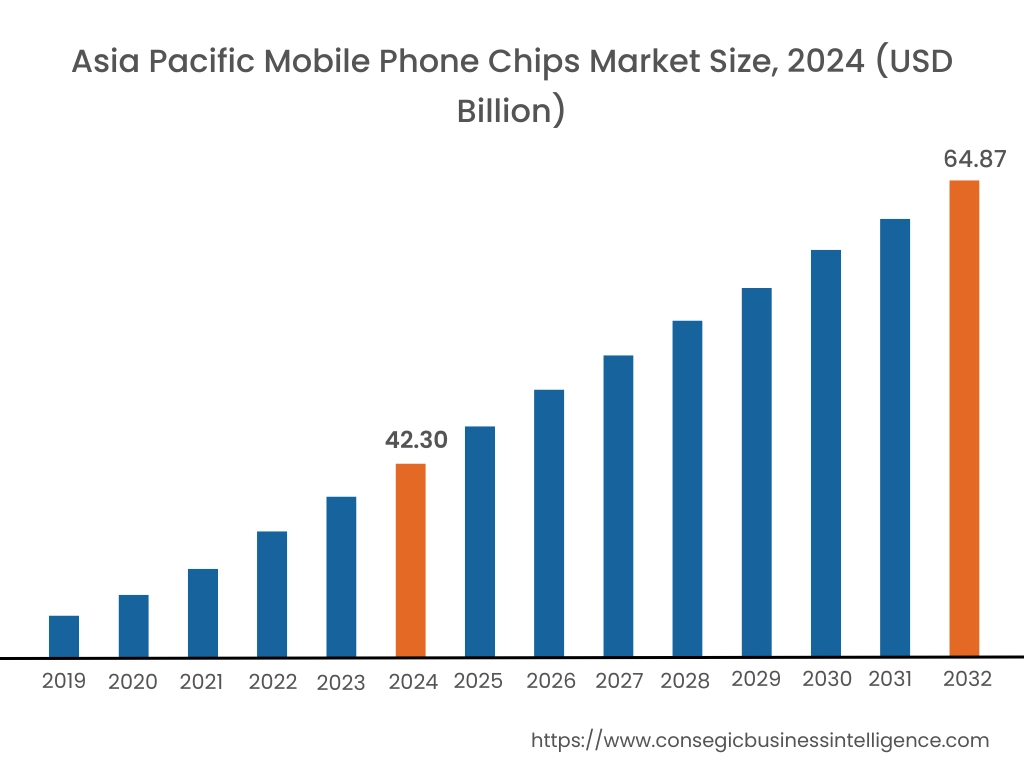
Asia Pacific region was valued at USD 42.30 Billion in 2024. Moreover, it is projected to grow by USD 43.79 Billion in 2025 and reach over USD 64.87 Billion by 2032. Out of this, China accounted for the maximum revenue share of 36.24%. As per the mobile phone chips market analysis, the adoption of smartphone chipset in the Asia-Pacific region is primarily driven by the rising smartphone production and increasing popularity of high-end smartphones among others. Additionally, the rising adoption of smartphone chipset with advanced features is further accelerating the mobile phone chips market expansion.
- For instance, in January 2025, OnePlus, a smartphone manufacturer based in China, announced the launch of OnePlus 13R, a smartphone which utilizes 3nm Snapdragon 8 gen 3 processor. The above factors are driving the market in the Asia-Pacific region.
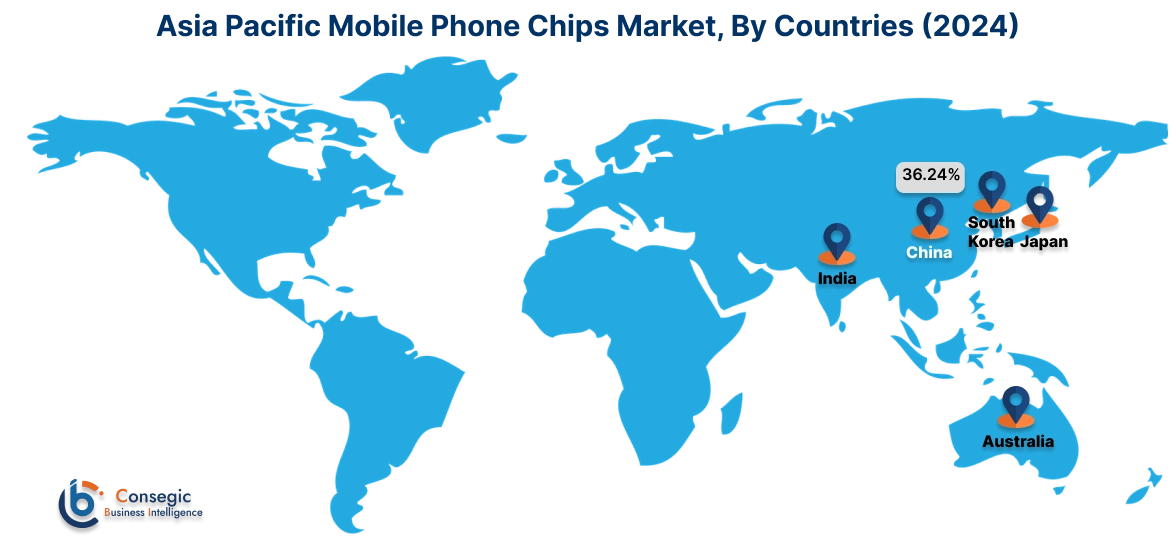
North America is estimated to reach over USD 46.93 Billion by 2032 from a value of USD 31.47 Billion in 2024 and is projected to grow by USD 32.50 Billion in 2025. In North America, as per the mobile phone chips market analysis, the market growth in the region is driven by the growing investments in smartphone industry. Moreover, the prevalence of several smartphone manufacturers and increasing smartphone production are contributing to the mobile phone chips market demand.
- For instance, in August 2024, Google launched its new Google Pixel 9 pro smartphone, which utilizes 4nm google tensor G4 processor for enhanced features and greater efficiency. Thus, the above factors are increasing the demand for mobile phone chips in North America.
Additionally, the regional analysis depicts that the rising smartphone sales, increasing adoption of 5G smartphones, and others are driving the mobile phone chips market demand in Europe. Furthermore, as per the market analysis, the market demand in Latin America, Middle East, and African regions is expected to grow at a considerable rate due to increasing pace of digitalization and rising adoption of smartphones among others.
Top Key Players and Market Share Insights:
The global mobile phone chips market is highly competitive with major players providing products to the national and international markets. Key players are adopting several strategies in research and development (R&D), product innovation, and end-user launches to hold a strong position in the mobile phone chips market. Key players in the mobile phone chips industry include-
- Samsung Electronics (South Korea)
- Qualcomm Inc. (U.S.)
- MediaTek (Taiwan)
- NVIDIA Corporation (U.S.)
- Taiwan Semiconductor Manufacturing Co. Ltd. (Taiwan)
- Intel Corporation (U.S)
- Broadcom Inc. (U.S.)
- Fuzhou Rockchip Electronics Co. Ltd. (China)
- ASM Lithography Holding N.V (Netherlands)
- Applied Materials Inc. (U.S.)
Recent Industry Developments :
Product Launch:
- In October 2024, MediaTek’s latest flagship model chipset called Dimensity 9400 was launched. Moreover, the MediaTek Dimensity 9400+ chipsetis designed to provide exceptional AI performance, including support for the latest large language models (LLMs) and advanced generative and agentic AI capabilities.
Mobile Phone Chips Market Report Insights :
| Report Attributes | Report Details |
| Study Timeline | 2019-2032 |
| Market Size in 2032 | USD 166.77 Billion |
| CAGR (2025-2032) | 5.5% |
| By Core Type |
|
| By Processing Node |
|
| By Region |
|
| Key Players |
|
| North America | U.S. Canada Mexico |
| Europe | U.K. Germany France Spain Italy Russia Benelux Rest of Europe |
| APAC | China South Korea Japan India Australia ASEAN Rest of Asia-Pacific |
| Middle East and Africa | GCC Turkey South Africa Rest of MEA |
| LATAM | Brazil Argentina Chile Rest of LATAM |
| Report Coverage |
|
Key Questions Answered in the Report
How big is the mobile phone chips market? +
The mobile phone chips market was valued at USD 111.87 Billion in 2024 and is projected to grow to USD 166.77 Billion by 2032.
Which is the fastest-growing region in the mobile phone chips market? +
Asia-Pacific is the region experiencing the most rapid growth in the mobile phone chips market.
What specific segmentation details are covered in the mobile phone chips report? +
The mobile phone chips report includes specific segmentation details for core type, processing node, end user, and region.
Who are the major players in the mobile phone chips market? +
The key participants in the mobile phone chips market Samsung Electronics (South Korea), Qualcomm Inc. (U.S.), MediaTek (Taiwan), NVIDIA Corporation (U.S.), Taiwan Semiconductor Manufacturing Co. Ltd. (Taiwan), Intel Corporation (U.S), Broadcom Inc. (U.S.), Fuzhou Rockchip Electronics Co. Ltd. (China), ASM Lithography Holding N.V (Netherlands), Applied Materials Inc. (U.S.), and others.

